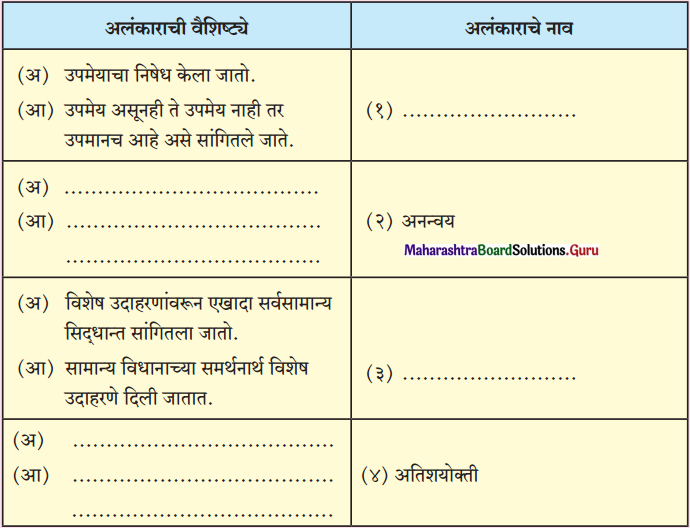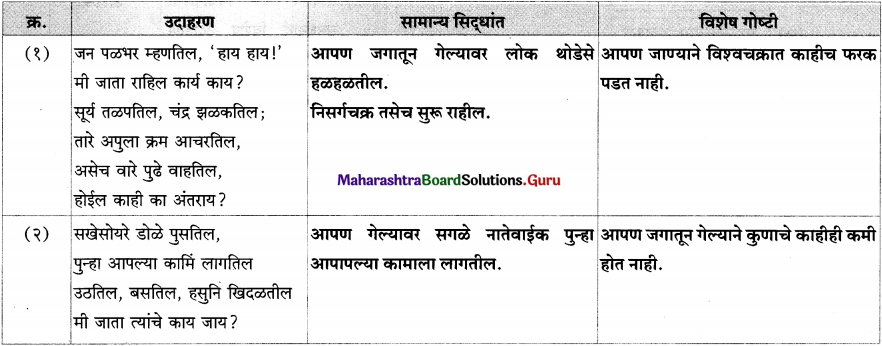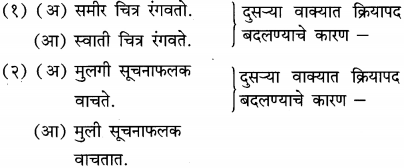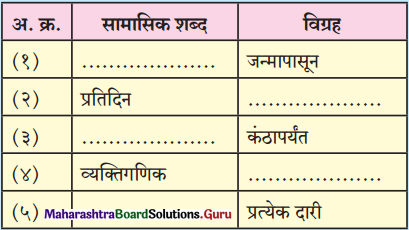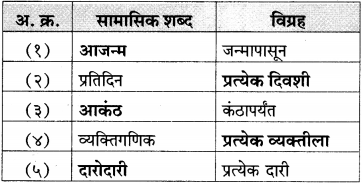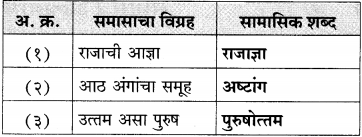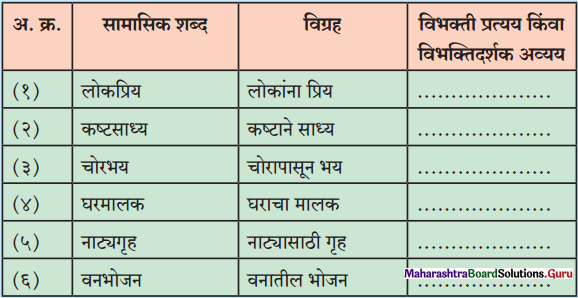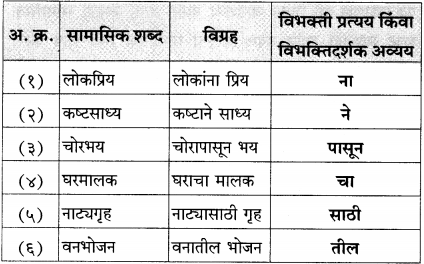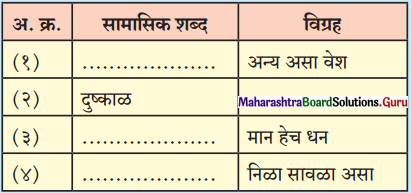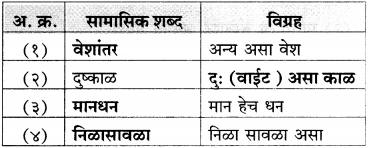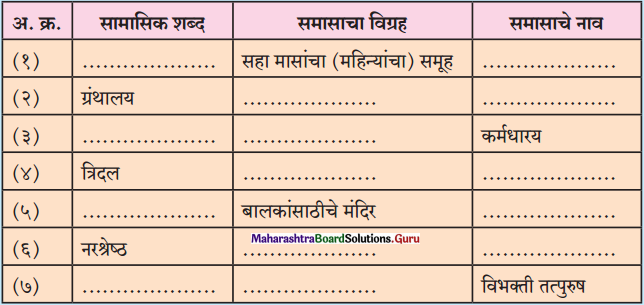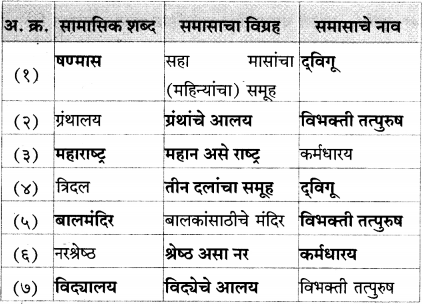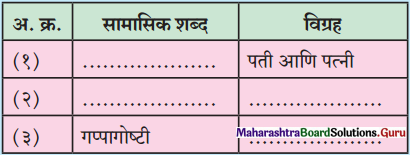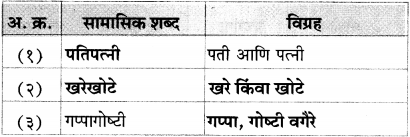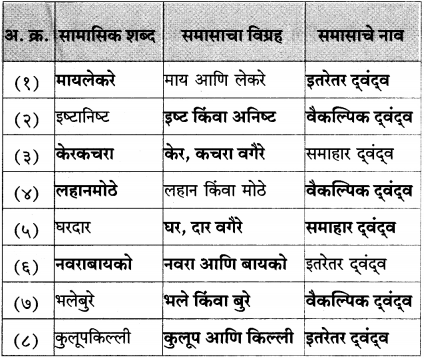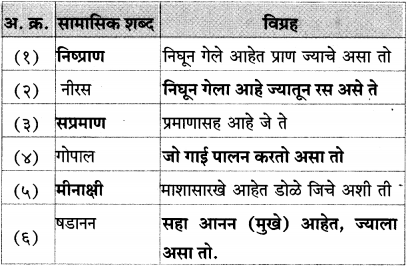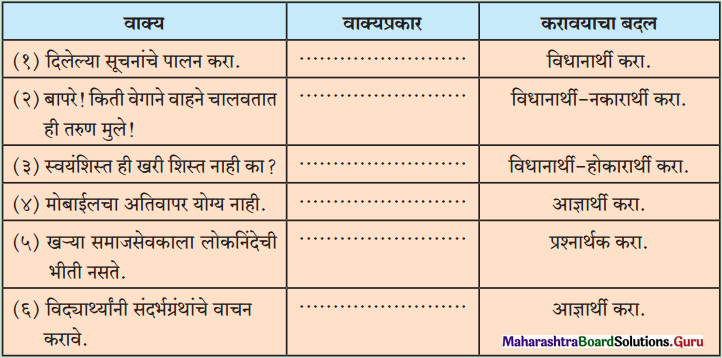Balbharti Maharashtra State Board Marathi Yuvakbharati 12th Digest निबंध लेखन Notes, Textbook Exercise Important Questions and Answers.
Maharashtra State Board 12th Marathi Yuvakbharati Solutions निबंध लेखन
12th Marathi Guide निबंध लेखन Textbook Questions and Answers
कृती
खालील विषयांवर निबंधलेखन करा.
प्रश्न 1.
वर्णनात्मक निबंध-
पहाटेचे सौंदर्य.
आमची अविस्मरणीय सहल.
उत्तर :
वर्णनात्मक निबंध दैनंदिन जीवनात आपण पाहिलेल्या व्यक्तींचे, प्रसंगांचे, दृश्यांचे किंवा वस्तूंचे शब्दांनी केलेले प्रत्ययकारक चित्रण म्हणजे वर्णनात्मक निबंध होय.
वर्णिलेल्या प्रसंगांतील, दृश्यांतील, मानवी स्वभावांतील बारकाव्यांचा तपशील येणे वर्णनात्मक निबंधात आवश्यक असते. समजा, आपण एखादया व्यक्तीचे वर्णन करीत आहोत; अशा वेळी त्या निबंधात त्या व्यक्तीच्या सद्गुणांचे वर्णन येणारच. पण त्याचबरोबर (त्या व्यक्तीमधील उणिवाही सांगितल्या पाहिजेत. तसेच, तिच्या हालचाली, लकबी, सवयी यांतील बारकावे सांगितले पाहिजेत. म्हणजे ती व्यक्ती आपल्या डोळ्यांसमोर जशीच्या तशी उभी राहते. असे लेखन घडले, तर तो चांगला वर्णनात्मक निबंध ठरेल.
व्यक्तीच्या वर्णनाप्रमाणेच वस्तू, ठिकाण, दृश्य, प्रसंग यांचेही हुबेहूब, प्रत्ययकारी वर्णन लिहिता आले पाहिजे. ती वस्तू , ते ठिकाण आपण समोर उभे राहून पाहत आहोत, असा प्रत्यय आला पाहिजे. प्रत्ययकारकता हा वर्णनात्मक निबंधाचा प्राण आहे.
नोंद : येथे निबंधात विदयार्थ्यांच्या मार्गदर्शनार्थ मुद्दे दिलेले आहेत. परीक्षेत केवळ निबंधांचे विषय देण्यात येतात, याची नोंद घ्यावी.
वर्णनात्मक निबंधाचा एक नमुना :
घरातील एक उपद्रवी कीटक
[मुद्दे : उपद्रवकारक कीटकांचा प्राथमिक परिचय – त्रासाचे स्वरूप – कीटकांविषयी कुतूहल – कीटकांचे स्थूल स्वरूप – वागण्याची वैशिष्ट्यपूर्ण रीत – कीटकांपासून होणारा महत्त्वाचा त्रास – त्या कीटकांची पैदास – त्या कीटकांच्या निर्मूलनाचा मार्ग.]
माशी ही परमेश्वराप्रमाणे सर्वव्यापी व सर्वसंचारी आहे. कोठेही जा. तुम्हांला माशी आढळणारच. मी तरी माशी नसलेले ठिकाण अजून पाहिलेले नाही. माझ्या मते, माणसाला उपद्रव देणाऱ्या कीटकांमध्ये, माशीचा पहिला क्रमांक लागतो. डास त्रासदायक आहे, यात शंकाच नाही. पण त्याच्यापेक्षा माशी अधिक त्रासदायक आहे, असे माझे ठाम मत आहे. डासांना अटकाव करण्यासाठी वा त्यांना मारण्यासाठी औषधे, फवारण्या व अगरबत्त्या बाजारात मिळतात. पण माश्यांविरुद्ध असे काही उपाय केले जात असल्याचे दिसत नाही.
माश्या आणि उपद्रव या दोन्ही बाबी सोबत सोबतच असतात. डासांप्रमाणे माश्या चावत नाहीत. काही रोगांशी डासांचा संबंध घट्ट जोडला गेला आहे. तसे माश्यांबाबत नाही. म्हणून माश्या निरुपद्रवी वाटत असाव्यात. आणि माश्यांना बहुधा हे कळले असावे. त्यामुळे त्या एकदम अंगचटीलाच येतात. त्यांना हाकलण्याचा कितीही प्रयत्न करा; त्या तात्पुरत्या सटकतात आणि पुन्हा पुन्हा अंगावर येतात. आपण एकाग्रतेने अभ्यासाला बसावे किंवा निवांतपणे टीव्ही पाहत असावे, तर माशीचा फेरा सुरू झालाच म्हणून समजा.
आपण तिला अगदी अव्वल गुप्तहेराच्या चतुराईने मारण्याचा प्रयत्न केला, तरी ती तावडीत सापडत नाहीच. त्यानंतर ती परत येऊन बसते कुठे? तर पाठीवर, मानेवर वा कपाळावर अशा आपल्याला न दिसणाऱ्या जागेवर! मग तिला फक्त निकराने हाकलतच राहावे लागते. ती मात्र सुरक्षितरीत्या पळत राहते, एखादया कुशल खो – खो खेळाडूप्रमाणे! अशा वेळी ती आपल्याला कुत्सितपणे हसत असणार, असे अनेकदा माझ्या मनात येऊन गेले आहे. ती चावत नाही; पण सारखी सुळसुळत राहते. त्यामुळे चित्त विचलित होत राहते. चैन पडत नाही. आपण एकाग्रतेने काहीही करू शकत नाही. मन अस्वस्थ होते आणि मनाची चिडचिड चिडचिड होते!
खरे पाहता, माशीच्या आकाराच्या तुलनेत आपण म्हणजे महाकाय, अक्राळविक्राळ राक्षसच! तरीही ती आपल्याला घाबरत कशी नाही? पुन्हा पुन्हा अंगावर येऊन बसते कशी? प्रत्येक वेळी ती यशस्वीरीत्या सटकते कशी? याचे मला प्रचंड कुतूहल होते. हे कुतूहल मला काही केल्या गप्प बसू देईना. मग मी मराठी विश्वकोश उघडला. त्यातील माशीची माहिती वाचली आणि थक्कच झालो. तिच्या सुरक्षितरीत्या पळण्याचे रहस्यच मला उलगडले.
माशीच्या डोक्यावर दोन मोठे टपोरे डोळे असतात. त्या डोळ्यांत प्रत्येकी चार हजार नेत्रिका असतात. नेत्रिका म्हणजे काय माहीत आहे का? आपण सूक्ष्मदर्शक उपकरणाच्या साहाय्याने अत्यंत लहान, सूक्ष्म वस्तू मोठी करून पाहतो. सूक्ष्मदर्शकाच्या ज्या भिंगातून आपण पाहतो, त्या भिंगाला नेत्रिका म्हणतात. म्हणजे आठ हजार भिंगांमधून माशी भोवतालचा परिसर पाहते. शिवाय तिला आणखी तीन साधे डोळे असतातच. त्यामुळे माशी मान न हलवता एकाच क्षणी सर्व दिशांनी भोवताली पाहू शकते. लक्षात घ्या – आपल्याला फक्त समोरचेच दिसते. माशीला मात्र हालचाल न करता सगळीकडचे दिसते. म्हणूनच तिला कोणत्याही दिशेने येणाऱ्या संकटाची चाहूल तत्काळ लागते आणि ती त्वरेने पळ काढू शकते.
एकदा दुपारी मी शाळेतून घरी आलो आणि समोरचे दृश्य पाहून चकितच झालो. एका बशीच्या काठावर माश्या ओळीने गोलाकार बसल्या होत्या – उंच टांगलेल्या केबलवर कावळे ओळीने बसतात तशा. गुपचूप बाजूला झालो. माझ्या काकांचे मोठे बहिर्गोल भिंग घेऊन आलो आणि त्या भिंगातून माश्यांचे निरीक्षण करू लागलो.
प्रत्येक माशीला सहा पाय होते. सर्व माश्या सहाही पायांवर उभ्या होत्या. मधूनमधून पुढचे दोन पाय वर उचलून ते हातासारखे वापरत होत्या. ” कधी दोन्ही हात एकमेकांवर घासायच्या; तर कधी चेहऱ्यावरचे पाणी निपटून टाकावे त्याप्रमाणे चेहऱ्यावरून हात फिरवायच्या. जणू त्यांचा स्वच्छतेचा कार्यक्रम चालू होता! मला हसूच येऊ लागले. कुजलेले पदार्थ, शेण, लीद, मलमूत्र, गटारे अशा ठिकाणी रममाण होणाऱ्या आणि तिथेच अंडी घालणाऱ्या या माश्या स्वच्छता करीत होत्या!
त्यांच्या पायांवर दाट केस होते. या केसांत अक्षरश: लाखो सूक्ष्म रोगजंतू घर करून राहतात. त्या आपल्या अन्नपदार्थांवर येऊन बसतात. मग ते रोगजंतू आपल्या अन्नात मिसळतात. आपल्याला कॉलरा, हगवण, टायफॉईड यांसारख्या रोगांची लागण होते. आपल्या देशात या रोगांमुळे काही हजार माणसे दरवर्षी दगावतात. केवढा हा माश्यांचा उपद्रव!
माश्यांच्या उपद्रवामुळे मी त्यांचा बारकाईने विचार केला आहे. मला एक शोध लागला आहे. माश्यांचा नायनाट करायला औषधे, फवारण्या वगैरेंची अजिबात गरज नाही. माश्यांना घाण प्रिय असते. म्हणून आपण घाणच नाहीशी करायची. घाण होऊच दयायची नाही. सदोदित स्वच्छता पाळायची, बस्स. केवढा सुंदर महामार्ग आहे हा!
प्रश्न 2.
व्यक्तिचित्रणात्मक निबंध –
माझा आवडता कलावंत.
माझे आवडते शिक्षक.
उत्तर :
व्यक्तिचित्रणात्मक निबंध
व्यक्तिचित्रणात्मक निबंधात व्यक्तीचे चित्रण केलेले असते. प्रसंगवर्णनात प्रसंगाचे शब्दचित्र असते. त्या चित्रणात प्रसंगाचे लक्षवेधक, प्रभावी वर्णन केलेले असते. तो प्रसंग वाचकाच्या डोळ्यांसमोर उभा राहतो. आपण जणू काही तो प्रसंग पाहतच आहोत, असा वाचकाला प्रत्यय येत राहतो. त्याप्रमाणेच व्यक्तिचित्रणात व्यक्ती डोळ्यांसमोर उभी करण्याचे सामर्थ्य असले पाहिजे. जिवंत व्यक्तीच आपण पाहत आहोत, असा वाचकाला प्रत्यय आला पाहिजे. म्हणून व्यक्तीचे दिसणे, तिच्या हालचाली, लकबी, बोलण्याच्या पद्धती, विचार, दृष्टिकोन वगैरेंपैकी काही घटकांच्या किंवा अनेक घटकांच्या आधारे ती व्यक्ती साकार करता यायला हवी.
व्यक्तिचित्रणासाठी व्यक्ती नामवंत, वलयांकित, इतिहासप्रसिद्ध असली पाहिजे असे मुळीच नाही. व्यक्ती कोणीही असू शकते. अट एकच – चित्रण हुबेहूब वठले पाहिजे. त्यात व्यक्तिमत्त्वाचे जास्तीत जास्त पैलू प्रकट झाले पाहिजेत. असे व्यक्तिचित्रण हे यशस्वी व्यक्तिचित्रण होय.
व्यक्तिचित्रणात्मक निबंधाचा एक नमुना :
आमचे मनोहरकाका
[मुद्दे : व्यक्तीची प्राथमिक ओळख – लेखकाशी नाते – दर्शनी रूप – पेहराव – वृत्ती – व्यक्तीची इतरांशी वागण्याची पद्धत – सहवासाचा परिणाम – व्यक्तीचे उपजीविकेचे साधन – छंद – छंदाचे महत्त्व – लेखकाला झालेला फायदा.]
आमच्या शेजारचे मनोहरकाका आमच्या कॉलनीतील आम्हा मित्रमंडळींचे लाडके दोस्त आहेत. आम्हा सगळ्यांना ते खूप आवडतात. नेहमी हसतमुख चेहरा. आम्ही त्यांना कधीही कंटाळलेले, वैतागलेले, त्रागा करीत असलेले असे पाहिलेले नाही. त्यांच्या अंगावर स्वच्छ, इस्त्री केलेले नीटनेटके कपडे असतात. शर्ट नेहमी पँटीत खोचलेले असते. ते ठरावीक दोन – तीनच रंगांचे कपडे वापरतात, असे नाही. त्यांच्या अंगावर विविध रंग सुखाने नांदत असतात.
त्यातही त्यांना टी – शर्ट खूप प्रिय आहेत. हे टी – शर्टसुद्धा ते पॅन्टीत खोचतात, साधारणपणे टी – शर्ट खोचल्यानंतर बहुतेक लोक कमरेचा पट्टा बांधतात. पण मनोहरकाकांच्या बाबतीत गमतीची गोष्ट अशी की त्यांनी कधीही कमरेचा पट्टा वापरलेला नाही. त्यांची प्रकृती नेहमी टुणटुणीत असते. मनोहरकाका आणि प्रसन्नता नेहमी एकत्रच येतात.
मनोहरकाकांचा एक गुण आम्हांला खूप म्हणजे खूपच आवडतो. त्यांनी आम्हांला, “आज अभ्यास केला की नाही? की नुसता खेळण्यात वेळ गेला? किती गुण मिळाले?” असले प्रश्न कधीही विचारले नाहीत. पण त्यांचे आमच्या शिक्षणाकडे लक्ष नव्हते, असे नाही. आम्हा मित्रांच्या आई – बाबांशी त्यांची सतत कोणत्या ना कोणत्या योजनांविषयी चर्चा चालू असे. त्यांनी कॉलनीतील आठवी – नववी – दहावीतील मुलांसाठी विज्ञान प्रयोगशाळा सुरू केली आहे. तसेच, त्यांचे आम्हांला एक आग्रहाचे सांगणे असते, “इंग्रजीवर प्रभुत्व मिळवा. इंग्रजी वर्तमानपत्रे, मासिके वाचा. इंग्रजी पुस्तके वाचत राहा.
इंग्रजी कार्यक्रम पाहा. इंग्रजी बातम्या पाहा. डिक्शनरीची फिकीर करू नका”. मी आठवीत असल्यापासून त्यांचे हे म्हणणे मनावर घेतले. मी मराठी माध्यमातून शिकलो. दहावीनंतर मी कॉलेजमध्ये गेलो. तिथे मला इंग्रजीचा काहीही त्रास झाला नाही. मी आरामात आणि आनंदाने कॉलेजमध्ये वावरलो. शिकतानाही अडथळे आले नाहीत. खरे सांगू? मनोहरकाका माझ्या सोबतच आहेत, असे मला सतत वाटत राहिले आहे.
मनोहरकाकांची स्मरणशक्ती अफाट आहे. त्यांना देशोदेशीच्या इतक्या घटना, माणसे स्मरणात आहेत की विचारता सोय नाही. त्यांचे घर पुस्तकांनी भरलेले आहे. त्यांचे वाचन अफाट आहे. ते प्राध्यापक आहेत. कॉलेजात इतिहास शिकवतात. इतिहास त्यांच्या जिभेवर असतो. त्यांच्याकडे माहितीचा प्रचंड खजिना आहे. शिवाय त्याचे सगळे छापील पुरावे त्यांनी जपून ठेवले आहेत. साठ – सत्तर वर्षांपासूनची वर्तमानपत्रांची, साप्ताहिकांची, मासिकांची कात्रणे त्यांनी जमा केलेली आहेत. विषयानुसार कालानुक्रमे त्यांनी ती कात्रणे लावली आहेत. त्यांच्या फाईली करून ठेवल्या आहेत. स्पर्धांसाठी, स्पर्धा परीक्षांसाठी मनोहरकाकांचा आम्हांला खूप उपयोग होतो.
मी दहावी पास झालो. मला चांगले गुण मिळाले. मनापासून माझे कौतुक केले. पण त्याच वेळी आमच्या घरात एक पेच निर्माण झाला होता. मला आर्ट्स शाखेत प्रवेश घ्यायची इच्छा होती. माझ्या आई – ५ बाबांना ती कल्पना पसंत नव्हती. आम्ही मनोहरकाकांचा सल्ला घ्यायला गेलो. क्षणाचाही विलंब न लावता त्यांनी माझ्या निर्णयाचे कौतुक केले. मी आर्ट्स शाखेत प्रवेश घेतला. या वर्षी मी बारावीत आहे. कॉलेजातला माझा सगळा काळ आनंदात गेलेला आहे. असे आहेत आमचे मनोहरकाका. त्यांना तुम्ही एकदा जरी भेटलात, तरी त्यांचे मित्र होऊन जाल!
प्रश्न 3.
आत्मवृत्तात्मक निबंध-
मी सह्याद्री बोलतोय.
वृत्तपत्राचे मनोगत.
उत्तर :
आत्मवृत्तात्मक (आत्मकथनात्मक) निबंध
या प्रकारच्या निबंधामध्ये सजीव व निर्जीव वस्तू स्वत:च स्वत:च्या जीवनाचे कथन करीत आहेत, अशी कल्पना केलेली असते. या प्रकाराला आत्मनिवेदन, आत्मवृत्त, मनोगत, कैफियत, गाहाणे इत्यादी वेगवेगळे शब्दही योजले जातात.
या निबंधप्रकारात, निवेदक स्वत:च बोलत असल्याने प्रथमपुरुषी वाक्यरचना येते. या कथनात निवेदकाच्या जन्मापासूनच्या संपूर्ण बारीकसारीक तपशिलांची अपेक्षा नसते. त्याच्या जीवनातील ठळक, महत्त्वाचे मोजकेच प्रसंग वा घडामोडी नमूद कराव्यात. त्या आधारे त्याच्या व्यथा – वेदना कथन कराव्यात; या व्यथा – वेदना कथन करता मानवी जीवनातील, माणसाच्या वर्तनातील विसंगती दाखवून दयाव्यात, अशी अपेक्षा असते. मनोगत व्यक्त करताना सुप्त, अतृप्त इच्छा प्रकट करावी. गा – हाणी, कैफियत लिहिताना निवेदकाच्या सुखदुःखावर भर दयावा. निवेदक स्वतः वाचकाशी बोलत असतो. म्हणून या निबंधाची भाषा साधी व ओघवती असावी. निवेदनात जिव्हाळा, कळकळ, भावनेचा ओलावा व्यक्त झाला पाहिजे.
आत्मवृत्तात्मक (आत्मकथनात्मक) निबंधाचा एक नमुना :
भटक्या जमातीतील एका भटक्याचे मनोगत
[मुद्दे : भटकी जमात सतत भटकत असते – पण दारिद्र्य त्यांच्या पाचवीला पुजलेले – डॉ. बाबासाहेब आंबेडकरांचे प्रयत्न – भटके जीवन – स्थिरता नाही – गावोगावी भटकणे – भटकंतीमुळे सतत ताटातूट – भटकंतीत साथ प्राण्यांची – अपमानित जीवन – फुले, शाहू महाराज, डॉ. आंबेडकर यांच्यामुळे नवीन जीवन – प्रेरणा – अजूनही सुधारणेची गरज.]
“खरोखर आज मला फार आनंद झाला आहे. कारण अशा त – हेने आपल्या मनातील विचार समाजातील सगळ्या लोकांपुढे आपण कधी मांडू शकू, असे मला स्वप्नातही वाटले नव्हते. खरं सांगू का? असं एका जागी उभं राहून बोलण्याचीही मला सवय नाही, कारण… कारण आम्ही आहोत ‘भटके’ लोक ! सतत भटकतच असतो! आमच्या पायांना मुळी चक्रच लावलेलं असतं. पण एक शंका माझ्या मनात बरेच दिवस रेंगाळते आहे. ती तुमच्यापुढे मांडतो. असं म्हणतात की – जो चालतो, त्याचं नशीबही जोरात चालतं. जर असं आहे तर आम्हां भटक्यांचं नशीब का कधीच जोरात धावत नाही? आमची गाठ सदैव दारिद्र्याशीच का? आज वर्षानुवर्षे आम्ही हिंडत आहोत, पण जगातील कोणाचंही आमच्याकडे लक्ष गेलं नाही.
“आता मात्र दिवस हळहळ पालटू लागले आहेत. आमच्या दैन्यावस्थेकडे समाजाचे थोडं थोडं लक्ष जाऊ लागलं आहे. आमच्या मुलांपैकी काहीजण शिकू लागले आहेत. हे घडू लागलं आहे ते आमच्या परमपूज्य डॉ. बाबासाहेब आंबेडकरांमुळे. त्यांनी आम्हांला नवीन डोळे दिले; नवी दृष्टी दिली ! आम्ही अंधश्रद्धेच्या गुडूप अंधारात घनघोर झोपलो होतो. बाबासाहेबांनी आपल्या विचारांनी आम्हांला गदागदा हलवलं; आम्हांला जागं केलं. आम्हांला नवा मार्ग दाखवला. आम्ही त्या मार्गावर एकेक पाऊल टाकत आहोत.
“आता मी माझं मनोगत सांगतोय, तेव्हा मी माझी सुखदुःखे सांगावीत, असं तुमच्या मनात येईल. पण खरं सांगू का? सुखाचे क्षण मला शोधावेच लागतील. सगळं दु:खच दु:ख आलं आहे आमच्या वाट्याला! आम्हां भटक्यांना ना घर ना गाव! आम्ही सर्वजण गटागटाने हिंडत असतो… या गावातून त्या गावात. गावात गेल्यावर मुक्काम गावकुसाबाहेर. तेथेच फाटक्यातुटक्या कापडाच्या राहुट्या उभारतो. त्यांना आम्ही ‘पालं’ म्हणतो. दोन – चार दिवस राहतो. गावात दारोदार हिंडून काही काम मिळालं तर करतो आणि खातो आणि मग पालं गुंडाळून नव्या गावाच्या दिशेने पावलं टाकतो. वर्षानुवर्षे हे असंच चालू आहे.
“खरं सांगू का माझा जन्म कधी झाला व कोठे झाला, हे मला सांगता येणार नाही. आम्ही सगळी भावंडं अशीच भटकंतीत जन्मलो. आमचे जन्म, बारसे, लग्न सगळे या भटकंतीतच. जवळच्या माणसाचा मृत्यू झाला, तरी आम्हांला हे कळतं ते काही महिन्यांनी, कधी कधी तर वर्षानंतरही ! या भटक्या जीवनामुळे सगळ्या भावंडांची गाठ पडते, तीसुद्धा वर्षावर्षानंतर!
“भटक्या जीवनामुळे आम्हांला खडतर जीवनाची सवयच झाली आहे. कष्ट, दैन्य, हालअपेष्टा, मानापमान अशा गोष्टींचं काही वाटेनासंच झालं आहे. कधी कधी आम्ही पालं टाकतो आणि कोणीतरी येऊन शिवीगाळ करून आम्हांला हुसकावतं! आम्ही काहीही न बोलता भीतीने व दुःखी अंत:करणाने तिथून उठतो आणि दुसरीकडे जातो! आम्हांला कायम साथ देतात ती आमची मेंढरं, कुत्री आणि गाढवं ! आजारी पडायलाही आम्हांला फुरसत नसते.
आता आता आमच्यात थोडा बदल झाला आहे. छत्रपती शाहू महाराज हे देवदूतासारखे आमच्यासाठी धावून आले. आमच्यासाठी त्यांनी अपार कष्ट घेतले. आपल्या राजेपणाचे सर्व अधिकार त्यांनी आमच्यासाठी वापरले. आम्हांला स्थिर जीवन मिळावे म्हणून अनेक कल्पक योजना आखल्या. अनेकांची टीका सहन करीत त्या राबवल्या. आम्हांला माणसात आणण्याचा प्रयत्न केला. महात्मा फुले, शाहू महाराज, डॉ. बाबासाहेब आंबेडकर यांच्यासारख्यांच्या प्रयत्नांमुळे आता आमची मुलं शिकू लागली आहेत. वरच्या पदापर्यंत जाऊ लागली आहेत.
“इतर समाजसुद्धा हळूहळू बदलत आहे. लोक आमची स्थिती समजून घेत आहेत. सरकार आमच्यासाठी विविध योजना आखत आहे, कायदे करीत आहे. पण तरीही अजून खूप सुधारणा होण्याची गरज आहे. मग आपण एकसमान होऊ. आपला देश समर्थ बनेल.”
प्रश्न 4.
कल्पनाप्रधान निबंध –
सूर्य मावळला नाही तर…
पेट्रोल संपले तर…
उत्तर :
कल्पनाप्रधान निबंध
अशक्य वाटणारी गोष्ट शक्य झाल्यास काय घडेल या कल्पनेचा मुक्त वापर करून लिहिलेल्या निबंधाला कल्पनाप्रधान निबंध म्हणतात. आधुनिक जीवनव्यवहारात काही वस्तू अगदी अपरिहार्य झाल्या आहेत. त्या उपलब्ध नसल्यास काय घडेल, याचे वर्णन कल्पनाप्रधान निबंधात करता येते. परंतु त्याच वेळी त्या वस्तूंची आवश्यकता किती आहे, त्यामुळे आपल्या जीवनात किती सौंदर्य निर्माण झाले आहे किंवा किती कृत्रिमता निर्माण झाली आहे, हेही सांगता आले पाहिजे.
या निबंधप्रकाराची सुरुवात एखादया दैनंदिन प्रसंगातून करता येते. अशा निबंधाच्या विषयाची मांडणी करताना आपणाला ज्या गोष्टी सांगायच्या असतात, त्या एखादया कल्पनेभोवती गुंफून सांगाव्यात.
कल्पनाप्रधान निबंधाचा एक नमुना :
आषाढघनाचे आगमन झाले नाही तर?
[मुद्दे : असा प्रश्न मनात येण्याचे कारण – प्रथम जाणवणारा दुष्परिणाम – – निसर्गसौंदर्याचा नाश – आषाढ धो धो पावसाचा महिना – अतिवृष्टीच्या परिणामांपासून मुक्ती – पाण्याच्या अभावाचे परिणाम – मानवी प्रयत्न – पाणी मिळवणे महागडे – पाण्याविना तडफडणारी सर्वच प्राणिसृष्टी – आधुनिक जीवन ठप्प – गरीबश्रीमंत दरी – सर्वनाशाकडे वाटचाल.]
मध्यंतरी कोरोनाने अक्षरश: हैदोस घातला होता. जगातली सर्व कुटुंबे आपापल्या घरात कोंडून पडली होती. माणसाच्या गेल्या दहा हजार वर्षांच्या इतिहासात पहिल्यांदाच घडले हे. निसर्गाने माणसाला शिक्षाच दयायला सुरुवात केली नसेल ना? गेली दहा हजार वर्षे माणूस स्वार्थासाठी निसर्गाला ओरबाडतो आहे. पर्यावरण उद्ध्वस्त करीत आहे. त्याचा बदला तर नाही ना हा? आणखी काय काय घडणार आहे कोण जाणे! सध्याचाच ताप पाहा आधी. तापमानाचा पारा ४०°ला स्पर्श करीत आहे. आता पाऊस येईल तेव्हाच गारवा. त्यातच पाऊस या वर्षी उशिरा आला तर? अरे देवा! पण तो आलाच नाही तर? आषाढघनाचे दर्शनच घडले नाही तर?
परवाच बा. भ. बोरकर यांची कविता वाचत होतो. वाचता वाचता हरखून गेलो होतो. या पावसाळ्यात जायचेच, असा आमच्या घरात बेत आखला जात होता. गावी जायला मिळाले, तर आषाढघनाने नटलेले निसर्गसौंदर्य डोळे भरून पाहता येईल. कोमल, नाजूक पाचूच्या रांगांची हिरवीगार शेते, पोवळ्याच्या रंगाची लाल माती, रत्नांच्या प्रभेसारखी बांबूची बेटे, सोनचाफा, केतकी, जाईजुई यांचे आषाढस्पर्शाने प्रफुल्लित झालेले सौंदर्य अनुभवायला मिळेल, हे खरे आहे. पण पाऊसच नसेल तर?
आषाढ महिना हा धुवाधार पावसाचा महिना. गडगडाटासह धो धो कोसळणाऱ्या पावसाचा महिना. कधी कधी हे आषाढघन रौद्ररूप धारण करतात. गावेच्या गावे जलमय होतात. डोंगरकडे कोसळतात. घरे बुडतात. गटारे ओसंडून वाहतात. सांडपाण्याची, मलमूत्राची सर्व घाण रस्तोरस्ती पसरते. घराघरात घुसते. मुकी जनावरे बिचारी वाहून जातात. हे सर्व परिणाम किरकोळ वाटावेत, अशी भीषण संकटे समोर उभी ठाकतात. दैनंदिन जीवन कोलमडून पडते. रोगराईचे तांडव सुरू होते. पाऊस नसेल, तर हे सर्व टळेल, यात शंकाच नाही.
मात्र, पाण्याशिवाय जीवन नाही. आणि माणूस हा तर करामती प्राणी आहे. तो पाणी मिळवण्याचे मार्ग शोधू लागेल. समुद्राचे पाणी वापरण्याजोगे करण्याचे कारखाने सुरू होतील. त्यामुळे प्यायला पाणी मिळेल. काही प्रमाणात शेती होईल. पण हे जेवढ्यास तेवढेच असेल.
सर्वत्र पाऊस पडत आहे. रान हिरवेगार झाले आहे. फळाफुलांनी झाडे लगडली आहेत, अशी दृश्ये कधीच आणि कुठेही दिसणार नाही. बा. भ. बोरकरांच्या कवितेतील रमणीय दृश्य हे कल्पनारम्य चित्रपटातील फॅन्टसीसारखे असेल फक्त.
समुद्रातून पाणी मिळवण्याचा उपाय तसा खूप महागडा असेल. त्यातून सर्व मानवजातीच्या सर्व गरजा भागवता येणे अशक्य होईल. उपासमार मोठ्या प्रमाणात होईल. दंगली घडतील. लुटालुटीचे प्रकार सुरू होतील.
थोडकीच माणसे शिल्लक राहिली, तर ती जगूच शकणार नाहीत. इतर प्राणी त्यांना जगू देणार नाहीत. माणूस फक्त स्वत:साठी पाणी मिळवील. पण उरलेल्या प्राणिसृष्टीचे काय? ही प्राणिसृष्टी माणसांवर चाल करून येईल. वरवर वाटते तितके जीवन सोपे नसेल. माणसांचे, प्राण्यांचे मृतदेह सर्वत्र दिसू लागतील. त्यांतून कल्पनातीत रोगांची निर्मिती होईल. एकूण काय? ती सर्वनाशाकडची वाटचाल असेल.
पाऊस नसेल, तर वीजही नसेल. एका रात्रीत सर्व कारखाने थंडगार पडतील. पाणी नसल्यामुळे शेती नसेल. फळबागाईत नसेल. नेहमीच्या अन्नधान्यासाठी माणूस समुद्रातून पाणी काढील, इथपर्यंत ठीक आहे. पण अन्य अनेक पिके घेणे महाप्रचंड कठीण होईल. या परिस्थितीतून अल्प माणसांकडे काही अधिकीच्या गोष्टी असतील. बाकी प्रचंड समुदाय दारिद्र्यात खितपत राहील. त्यातून प्रचंड अराजक माजेल. याची भीषण चित्रे रंगवण्याची गरजच नाही. अल्पकाळातच जीवसृष्टी नष्ट होईल. उरेल फक्त रखरखीत, रणरणते वाळवंट. सूर्यमालिकेतील कोणत्याच ग्रहावर जीवसृष्टी अशीच नष्ट झाली नसेल ना?
नको, नको ते प्रश्न आणि त्या दृश्यांची ती वर्णने! एकच चिरकालिक सत्य आहे. ते म्हणजे पाऊस हवा, आषाढघन बरसायला हवाच!
प्रश्न 5.
वैचारिक निबंध –
तंत्रज्ञानाची किमया.
वाचते होऊया.
उत्तर :
वैचारिक निबंध
वैचारिक निबंधात विचाराला महत्त्व असते. मात्र, सर्व वैचारिक निबंध एकाच स्वरूपाचे नसतात. (यामध्ये विचारप्रधान, चिंतनपर, समस्याप्रधान, चर्चात्मक अशा स्वरूपांचे निबंध असतात.) काही निबंधांत विचाराला महत्त्व असते. उदा., ‘अहिंसा हाच श्रेष्ठ धर्म’, ‘दया, क्षमा, शांती हाच जीवनाचा आधार’, ‘त्यागात मैत्रीचा आत्मा’ इत्यादी. काही निबंध समस्याप्रधान असतात. उदा., ‘पर्यावरणाचा हास’, ‘फॅशनचे वेड’, ‘बालमजुरी’, ‘बेकारी’, ‘स्त्रियांवरील अत्याचार’ इत्यादी. अशा निबंधांत समस्या मांडलेली असते आणि त्या अनुषंगाने लेखक आपले विचार मांडतो. तर काही निबंध हे वादविवादात्मक स्वरूपाचे असतात. उदा., ‘मोबाइल – शाप की वरदान’, ‘आजचे तरुण बिघडले आहेत काय?’, ‘आजची स्त्री – अबला की सबला?’ इत्यादी.
वैचारिक निबंध कोणत्याही स्वरूपाचा असला, तरी त्यात एक विचार मांडलेला असतो. कोणत्याही विषयाला नेहमी दोन बाजू असतात. एक अनुकूल आणि दुसरी प्रतिकूल. अशा निबंधात केवळ आपलीच बाजू – म्हणजे अनुकूल बाजू – मांडून चालत नाही. त्या विषयाची दुसरी बाजू – म्हणजे आपल्याला न पटणारी बाजूसुद्धा – मांडावी लागते.
अशा प्रकारच्या निबंधाची मांडणी साधारणपणे पुढील प्रकारची असते :
प्रास्ताविकात विषयाची सदयःस्थिती मांडावी. त्यानंतर विरुद्ध बाजू मांडावी. लगेचच त्या बाजूतील उणिवा दाखवाव्यात. याला ‘खंडन’ असे म्हणतात. मग आपली बाजू मांडावी. याला ‘मंडन’ असे म्हणतात. खंडन – मंडन करताना दाखले दयावेत. अखेरीला आपल्या विचाराबाबतचा स्वत:चा निष्कर्ष नोंदवावा.
वैचारिक निबंधाचा एक नमुना :
सादरीकरण – एक जीवनावश्यक कौशल्य
[मुद्दे : समूहात राहणे ही माणसाची जीवनावश्यक गरज – त्यामुळे इतरांसमोर कौशल्याने सादर होणे – दैनंदिन जीवनात अनौपचारिक सादरीकरण – आधुनिक जीवन गुंतागुंतीचे – सतत विविध समूहांसमोर सादर होण्याची निकड – विशिष्ट कौशल्ये आवश्यक – पूर्वीचे जीवन शांत, संथ – सादरीकरणाचा अभ्यास करणे निकडीचे.]
असे म्हणतात की, माणूस हा सामाजिक प्राणी आहे. तो समूह करून राहतो. तो एकेकटा, स्वतंत्रपणे जगूच शकणार नाही. तो माणसांत, माणसांसोबत राहतो. तो त्याचा जगण्याचा आधारच आहे. हा आधार नसेल, तर माणूस वेडापिसाच होईल. म्हणूनच, प्राचीन काळापासून ते अगदी आजतागायत जगभर सर्व देशांमध्ये माणसाला शिक्षा केली जाते ती तुरुंगवासाची. त्याला त्याच्या कुटुंबीयांपासून, मित्रांपासून, समाजापासून तोडून टाकण्याची ती शिक्षा असते. बाह्य जगाशी कोणताही संपर्क येऊ दयायचा नाही, हीच ती शिक्षा असते. ही शिक्षा माणसाला मृत्युदंडापेक्षाही भीषण वाटत आलेली आहे. समाजात राहणे ही त्याची जीवनावश्यक गरज आहे.
समाजात राहायचे म्हणजे दुसऱ्यांच्या सोबतीने, त्यांच्या सहकार्याने राहायचे. म्हणूनच ज्यांच्यासोबत आपण राहतो, वावरतो त्यांना आपल्या इच्छा – आकांक्षा, भावना – विचार समजावून सांगणे आवश्यक ठरते. इतरांच्या इच्छा – आकांक्षांना तडे न जाता आपल्या मनाप्रमाणे जगता आले पाहिजे. म्हणूनच आपल्या कल्पना – भावना, विचार इतरांना समजावून सांगणे हे अत्यंत कौशल्याचे ठरते. याच्यासाठी सादरीकरणाची गरज आहे. स्वत:ची मते पद्धतशीरपणे समजावून सांगण्यासाठी खास युक्तिवाद करावा लागतो. ही सर्व पद्धत म्हणजेच ‘सादरीकरण’ होय.
सादरीकरणाशिवाय माणूस नाही. सादरीकरण हा माणसाच्या जगण्याचाच एक भाग आहे. आपले बोलणे, चालणे, उठणे, बसणे, वागणे, हातवारे करणे किंबहुना आपली देहबोली हे आपले सादरीकरणच होय. या सादरीकरणातून आपले व्यक्तिमत्त्व व्यक्त होत असते. आपण फारच थोड्या कृती एकट्याने, खाजगीरीत्या करतो. आपले बहुतांशी जगणे इतरांसमोर, इतरांसोबतच घडत असते. म्हणजे आपण इतरांसमोर सदोदित सादरीकरणच करीत असतो म्हणा ना!
हे सादरीकरण अनौपचारिक पद्धतीने घडत असते. म्हणूनच आईवडील किंवा अन्य वडीलधारी माणसे “उठता – बसता काळजी घे”, “असा उभा राहू नकोस, तसा राहा’ या अशा सूचना करतात. इतरांसमोर आपले व्यक्तिमत्त्व चांगल्या रितीने प्रकट व्हावे, ही त्यांची इच्छा असते. म्हणजेच आपल्या देहबोलीला, आपल्या वागण्याबोलण्याला किती महत्त्व आहे, हे लक्षात येईल.
मात्र, आताचे जीवन खूप जटिल बनले आहे. खूप व्यामिश्र बनले आहे. जागतिकीकरणामुळे संपूर्ण मानवी जीवनच ढवळून निघाले आहे. कामांचे स्वरूप व व्याप्ती वाढली आहे. विविध प्रकारचे उदयोगव्यवसाय निर्माण झाले आहेत. संगणक, इंटरनेट, मोबाइल यांसारख्या माहिती तंत्रज्ञानाच्या दूतांमुळे सर्व व्यवहारांचे स्वरूप आरपार बदलले आहे. सामाजिक, सांस्कृतिक, आर्थिक क्षेत्रांत अनेकानेक घडामोडी घडताहेत. यासाठी चर्चा, परिषदा, मेळावे, बैठका, संमेलने, शिबिरे इत्यादी आयोजित केली जात आहेत. माणसांना विविध कारणांनी असे एकत्र यावे लागत आहे.
अशा वेळी समूहासमोर आपल्या कल्पना, आपली मते व्यक्त करण्याची, सगळ्यांना आपले विचार समजावून सांगण्याची वेळ येते. आधुनिक काळात या सगळ्याला आपल्याला सामोरे जावे लागत आहे. हे टाळता येणे शक्यच नाही. अन्यथा आपल्याला नोकरी, धंदा वा व्यवसाय करताच येणार नाही. येथे सादरीकरणाचा संबंध येतो. अशा या सादरीकरणाशिवाय आपण जगूच शकणार नाही.
काही वर्षांपूर्वीचे जीवन हे शांत, संथ होते. तेथे कोणाला, कशाचीही घाई नव्हती किंवा अगत्यही नव्हते. म्हणून कोणीही सैलपणाने वागला तरी ते चालून जाई. आता मात्र ते शक्य नाही. म्हणून सादरीकरणाचा अभ्यासही करावा लागेल. दुसऱ्यांसमोर आपण सादर होतो तेव्हा, उभे राहणे, बोलणे, हातवारे करणे या सगळ्यांचा काटेकोर अभ्यास करावा लागेल. कोणत्या हेतूने व कोणत्या प्रकारच्या लोकांसमोर आपण उभे राहिलो आहोत, हे लक्षात घेऊन आपल्याला आपल्या सादरीकरणाची रीत ठरवावी लागेल. सादरीकरण हे आता दुर्लक्ष करण्याएवढे बिनमहत्त्वाचे राहिले नाही. आपण शाळा – कॉलेजात अभ्यास करतो, तसा सादरीकरणाचा अभ्यास करावा लागेल. सातत्याने सराव करावा लागेल. तर आणि तरच आपला आधुनिक जगात टिकाव लागणार आहे.
निबंध लेखन प्रस्तावना
निबंध हा गदयलेखनाचा एक प्रकार आहे. त्यात एखादया विषयाची सांगोपांग माहिती सुसंगतपणे दयायची असते.
निबंधात कधी एखादया समस्येचा ऊहापोह केलेला असतो. समस्येचे स्वरूप, कारणे व उपाय या रितीने त्यात मांडणी केलेली असते. कधी एखादी वस्तू, ठिकाण, परिसर, प्रसंग, व्यक्ती यांचे वर्णन असते; तर कधी विविध सजीव – निर्जीव गोष्टींचे आत्मकथन असते. कधी कधी कल्पनेवर स्वार होऊन अनेक गोष्टींच्या अंतरंगात शिरण्याचा प्रयत्न असतो. त्याचप्रमाणे नकारात्मक गुणांचाही निर्देश करायला हरकत नसते. अशा प्रकारे निबंधात आशय विविध रितींनी मांडलेला असतो.
1. लक्षात ठेवा
- निबंधाची सुरुवात आकर्षक, लक्षवेधक हवी आणि आपले मत ठाशीवपणे मांडणारा परिणामकारक शेवट हवा.
- सुरुवातीच्या काळात कोणालाही कोणताही निबंध एका दमात, एका झटक्यात लिहिता येत नाही. पुन:पुन्हा सुधारणा करून पुनर्लेखन करावे लागते.
- परीक्षेत ठरावीक मिनिटांत निबंध लिहावा लागतो. पुन:पुन्हा लिहिण्यास वेळ नसतो. निबंध लिहिण्याचा सातत्याने सराव केला पाहिजे. निबंधाच्या विषयानुसार प्रथम मुद्दे तयार करावेत. ते क्रमाने मांडावेत. मुद्द्यांना अनुसरून परिच्छेद पाडले पाहिजेत.
- निबंध ठरावीक शब्दसंख्येत बसवावा. या त – हेने वेगवेगळ्या विषयांवरचे निबंध तयार करावेत.
- म्हणी, वाक्प्रचार, सुभाषिते, विविध भाषांतील अवतरणे यांचा गरजेनुसार व प्रमाणशीर वापर करावा.
- शब्दरचना व वाक्यरचना अर्थपूर्ण असावी. ज्या शब्दांचा अर्थ निश्चितपणे माहीत नाही, त्यांचा उपयोग करू नये.
- पाल्हाळीकपणा टाळावा.
- स्वत:च्या शब्दांतच निबंध लिहावा. दुसऱ्याचा निबंध उतरवून काढू नये किंवा त्याची घोकंपट्टी करू नये.
- लेखनाचे नियम, विरामचिन्हे यांबाबत दक्षता बाळगावी.
- शब्दसंपत्ती, भाषाशैली यांचा विकास व्हावा, म्हणून वृत्तपत्रे व पाठ्यपुस्तकेतर पुस्तके यांचे नियमित वाचन अवश्य करावे.
- टिपणे, कात्रणे यांचा संग्रह करण्याची सवय लावावी.
- शा प्रकारे सराव केल्यास मुद्देसूदपणे व आटोपशीरपणे निबंध लिहिण्याचे कौशल्य प्राप्त होते. परीक्षेत कोणत्याही विषयावरचा निबंध लिहिण्यास हे कौशल्य उपयोगी पडते.
2. अभ्यासक्रमातील निबंधाचे प्रकार :
निबंधाच्या आशयानुसार निबंधाचे अनेक प्रकार मानले जातात. त्यांपैकी पुढील पाच प्रकार इयत्ता १२वीच्या अभ्यासक्रमात समाविष्ट करण्यात आले आहेत :
कल्पनाप्रधान निबंधाचा एक नमुना :
आषाढघनाचे आगमन झाले नाही तर?
[मुद्दे : असा प्रश्न मनात येण्याचे कारण – प्रथम जाणवणारा दुष्परिणाम – निसर्गसौंदर्याचा नाश – आषाढ धो धो पावसाचा महिना – अतिवृष्टीच्या परिणामांपासून मुक्ती – पाण्याच्या अभावाचे परिणाम – मानवी प्रयत्न – पाणी मिळवणे महागडे – पाण्याविना तडफडणारी सर्वच प्राणिसृष्टी – आधुनिक जीवन ठप्प – गरीबश्रीमंत दरी – सर्वनाशाकडे वाटचाल.]
मध्यंतरी कोरोनाने अक्षरश: हैदोस घातला होता. जगातली सर्व कुटुंबे आपापल्या घरात कोंडून पडली होती. माणसाच्या गेल्या दहा हजार वर्षांच्या इतिहासात पहिल्यांदाच घडले हे. निसर्गाने माणसाला शिक्षाच दयायला सुरुवात केली नसेल ना? गेली दहा हजार वर्षे माणूस स्वार्थासाठी निसर्गाला ओरबाडतो आहे. पर्यावरण उद्ध्वस्त करीत आहे. त्याचा बदला तर नाही ना हा? आणखी काय काय घडणार आहे कोण जाणे! सध्याचाच ताप पाहा आधी. तापमानाचा पारा ४०°ला स्पर्श करीत आहे. आता पाऊस येईल तेव्हाच गारवा. त्यातच पाऊस या वर्षी उशिरा आला तर? अरे देवा! पण तो आलाच नाही तर? आषाढघनाचे दर्शनच घडले नाही तर?
परवाच बा. भ. बोरकर यांची कविता वाचत होतो. वाचता वाचता हरखून गेलो होतो. या पावसाळ्यात जायचेच, असा आमच्या घरात बेत आखला जात होता. गावी जायला मिळाले, तर आषाढघनाने नटलेले निसर्गसौंदर्य डोळे भरून पाहता येईल. कोमल, नाजूक पाचूच्या रांगांची हिरवीगार शेते, पोवळ्याच्या रंगाची लाल माती, रत्नांच्या प्रभेसारखी बांबूची बेटे, सोनचाफा, केतकी, जाईजुई यांचे आषाढस्पर्शाने प्रफुल्लित झालेले सौंदर्य अनुभवायला मिळेल, हे खरे आहे. पण पाऊसच नसेल तर?
आषाढ महिना हा धुवाधार पावसाचा महिना. गडगडाटासह धो धो कोसळणाऱ्या पावसाचा महिना. कधी कधी हे आषाढघन रौद्ररूप धारण करतात. गावेच्या गावे जलमय होतात. डोंगरकडे कोसळतात. घरे बुडतात. गटारे ओसंडून वाहतात. सांडपाण्याची, मलमूत्राची सर्व घाण रस्तोरस्ती पसरते. घराघरात घुसते. मुकी जनावरे बिचारी वाहून जातात. हे सर्व परिणाम किरकोळ वाटावेत, अशी भीषण संकटे समोर उभी ठाकतात. दैनंदिन जीवन कोलमडून पडते. रोगराईचे तांडव सुरू होते. पाऊस नसेल, तर हे सर्व टळेल, यात शंकाच नाही.
मात्र, पाण्याशिवाय जीवन नाही. आणि माणूस हा तर करामती प्राणी आहे. तो पाणी मिळवण्याचे मार्ग शोधू लागेल. समुद्राचे पाणी वापरण्याजोगे करण्याचे कारखाने सुरू होतील. त्यामुळे प्यायला पाणी मिळेल. काही प्रमाणात शेती होईल. पण हे जेवढ्यास तेवढेच असेल.
सर्वत्र पाऊस पडत आहे. रान हिरवेगार झाले आहे. फळाफुलांनी झाडे। लगडली आहेत, अशी दृश्ये कधीच आणि कुठेही दिसणार नाही. बा. भ. बोरकरांच्या कवितेतील रमणीय दृश्य हे कल्पनारम्य चित्रपटातील फॅन्टसीसारखे असेल फक्त.
समुद्रातून पाणी मिळवण्याचा उपाय तसा खूप महागडा असेल. त्यातून सर्व मानवजातीच्या सर्व गरजा भागवता येणे अशक्य होईल. उपासमार मोठ्या प्रमाणात होईल. दंगली घडतील. लुटालुटीचे प्रकार सुरू होतील. थोडकीच माणसे शिल्लक राहिली, तर ती जगूच शकणार नाहीत. इतर प्राणी त्यांना जगू देणार नाहीत. माणूस फक्त स्वत:साठी पाणी मिळवील. पण उरलेल्या प्राणिसृष्टीचे काय? ही प्राणिसृष्टी माणसांवर चाल करून येईल. वरवर वाटते तितके जीवन सोपे नसेल. माणसांचे, प्राण्यांचे मृतदेह सर्वत्र दिसू लागतील. त्यांतून कल्पनातीत रोगांची निर्मिती होईल. एकूण काय? ती सर्वनाशाकडची वाटचाल असेल.
पाऊस नसेल, तर वीजही नसेल. एका रात्रीत सर्व कारखाने थंडगार पडतील. पाणी नसल्यामुळे शेती नसेल. फळबागाईत नसेल. नेहमीच्या अन्नधान्यासाठी माणूस समुद्रातून पाणी काढील, इथपर्यंत ठीक आहे. पण अन्य अनेक पिके घेणे महाप्रचंड कठीण होईल. या परिस्थितीतून अल्प माणसांकडे काही अधिकीच्या गोष्टी असतील. बाकी प्रचंड समुदाय दारिद्र्यात खितपत राहील. त्यातून प्रचंड अराजक माजेल. याची भीषण चित्रे रंगवण्याची गरजच नाही. अल्पकाळातच जीवसृष्टी नष्ट होईल. उरेल फक्त रखरखीत, रणरणते वाळवंट. सूर्यमालिकेतील कोणत्याच ग्रहावर जीवसृष्टी अशीच नष्ट झाली नसेल ना?
नको, नको ते प्रश्न आणि त्या दृश्यांची ती वर्णने! एकच चिरकालिक १ सत्य आहे. ते म्हणजे पाऊस हवा, आषाढघन बरसायला हवाच!
वैचारिक निबंध
वैचारिक निबंधात विचाराला महत्त्व असते. मात्र, सर्व वैचारिक निबंध एकाच स्वरूपाचे नसतात. (यामध्ये विचारप्रधान, चिंतनपर, समस्याप्रधान, चर्चात्मक अशा स्वरूपांचे निबंध असतात.) काही निबंधांत विचाराला महत्त्व असते. उदा., ‘अहिंसा हाच श्रेष्ठ धर्म’, ‘दया, क्षमा, शांती हाच जीवनाचा आधार’, ‘त्यागात मैत्रीचा आत्मा’ इत्यादी. काही निबंध समस्याप्रधान असतात. उदा., ‘पर्यावरणाचा हास’, ‘फॅशनचे वेड’, ‘बालमजुरी’, ‘बेकारी’, ‘स्त्रियांवरील अत्याचार’ इत्यादी. अशा निबंधांत समस्या मांडलेली असते आणि त्या अनुषंगाने लेखक आपले विचार मांडतो. तर काही निबंध हे वादविवादात्मक स्वरूपाचे असतात. उदा., ‘मोबाइल – शाप की वरदान’, ‘आजचे तरुण बिघडले आहेत काय?’, ‘आजची स्त्री – अबला की सबला?’ इत्यादी.
वैचारिक निबंध कोणत्याही स्वरूपाचा असला, तरी त्यात एक विचार मांडलेला असतो. कोणत्याही विषयाला नेहमी दोन बाजू असतात. एक अनुकूल आणि दुसरी प्रतिकूल. अशा निबंधात केवळ आपलीच बाजू – म्हणजे अनुकूल बाजू – मांडून चालत नाही. त्या विषयाची दुसरी बाजू – म्हणजे आपल्याला न पटणारी बाजूसुद्धा – मांडावी लागते.
अशा प्रकारच्या निबंधाची मांडणी साधारणपणे पुढील प्रकारची असते :
प्रास्ताविकात विषयाची सदय:स्थिती मांडावी. त्यानंतर विरुद्ध बाजू मांडावी. लगेचच त्या बाजूतील उणिवा दाखवाव्यात. याला ‘खंडन’ असे म्हणतात. मग आपली बाजू मांडावी. याला ‘मंडन’ असे म्हणतात. खंडन – मंडन करताना दाखले दयावेत. अखेरीला आपल्या विचाराबाबतचा स्वत:चा निष्कर्ष नोंदवावा.
वैचारिक निबंधाचा एक नमुना :
सादरीकरण – एक जीवनावश्यक कौशल्य
[मुद्दे : समूहात राहणे ही माणसाची जीवनावश्यक गरज – त्यामुळे इतरांसमोर कौशल्याने सादर होणे – दैनंदिन जीवनात अनौपचारिक सादरीकरण – आधुनिक जीवन गुंतागुंतीचे – सतत विविध समूहांसमोर सादर होण्याची निकड – विशिष्ट कौशल्ये आवश्यक – पूर्वीचे जीवन शांत, संथ – सादरीकरणाचा अभ्यास करणे निकडीचे.]
असे म्हणतात की, माणूस हा सामाजिक प्राणी आहे. तो समूह करून राहतो. तो एकेकटा, स्वतंत्रपणे जगूच शकणार नाही. तो माणसांत, माणसांसोबत राहतो. तो त्याचा जगण्याचा आधारच आहे. हा आधार नसेल, तर माणूस वेडापिसाच होईल. म्हणूनच, प्राचीन काळापासून ते अगदी आजतागायत जगभर सर्व देशांमध्ये माणसाला शिक्षा केली जाते ती तुरुंगवासाची. त्याला त्याच्या कुटुंबीयांपासून, मित्रांपासून, समाजापासून तोडून टाकण्याची ती शिक्षा असते. बाह्य जगाशी कोणताही संपर्क येऊ दयायचा नाही, हीच ती शिक्षा असते. ही शिक्षा माणसाला मृत्युदंडापेक्षाही भीषण वाटत आलेली आहे. समाजात राहणे ही त्याची जीवनावश्यक गरज आहे.
समाजात राहायचे म्हणजे दुसऱ्यांच्या सोबतीने, त्यांच्या सहकार्याने राहायचे. म्हणूनच ज्यांच्यासोबत आपण राहतो, वावरतो त्यांना आपल्या इच्छा – आकांक्षा, भावना – विचार समजावून सांगणे आवश्यक ठरते. इतरांच्या इच्छा – आकांक्षांना तडे न जाता आपल्या मनाप्रमाणे जगता आले पाहिजे. म्हणूनच आपल्या कल्पना – भावना, विचार इतरांना समजावून सांगणे हे अत्यंत कौशल्याचे ठरते. याच्यासाठी सादरीकरणाची गरज आहे. स्वत:ची मते पद्धतशीरपणे समजावून सांगण्यासाठी खास युक्तिवाद करावा लागतो. ही सर्व पद्धत म्हणजेच ‘सादरीकरण’ होय.
सादरीकरणाशिवाय माणूस नाही. सादरीकरण हा माणसाच्या जगण्याचाच एक भाग आहे. आपले बोलणे, चालणे, उठणे, बसणे, वागणे, हातवारे करणे किंबहुना आपली देहबोली हे आपले सादरीकरणच होय. या सादरीकरणातून आपले व्यक्तिमत्त्व व्यक्त होत असते. आपण फारच थोड्या कृती एकट्याने, खाजगीरीत्या करतो. आपले बहुतांशी जगणे इतरांसमोर, इतरांसोबतच घडत असते. म्हणजे आपण इतरांसमोर सदोदित सादरीकरणच करीत असतो म्हणा ना!
हे सादरीकरण अनौपचारिक पद्धतीने घडत असते. म्हणूनच आईवडील किंवा अन्य वडीलधारी माणसे “उठता – बसता काळजी घे”, “असा उभा राहू नकोस, तसा राहा” या अशा सूचना करतात. इतरांसमोर आपले व्यक्तिमत्त्व चांगल्या रितीने प्रकट व्हावे, ही त्यांची इच्छा असते. म्हणजेच आपल्या देहबोलीला, आपल्या वागण्याबोलण्याला किती महत्त्व आहे, हे लक्षात येईल.
मात्र, आताचे जीवन खूप जटिल बनले आहे. खूप व्यामिश्र बनले आहे. जागतिकीकरणामुळे संपूर्ण मानवी जीवनच ढवळून निघाले आहे. कामांचे स्वरूप व व्याप्ती वाढली आहे. विविध प्रकारचे उदयोगव्यवसाय निर्माण झाले आहेत. संगणक, इंटरनेट, मोबाइल यांसारख्या माहिती तंत्रज्ञानाच्या दूतांमुळे सर्व व्यवहारांचे स्वरूप आरपार बदलले आहे. सामाजिक, सांस्कृतिक, आर्थिक क्षेत्रांत अनेकानेक घडामोडी घडताहेत. यासाठी चर्चा, परिषदा, मेळावे, बैठका, संमेलने, शिबिरे इत्यादी आयोजित केली जात आहेत. माणसांना विविध कारणांनी असे एकत्र यावे लागत आहे. अशा वेळी समूहासमोर आपल्या कल्पना, आपली मते व्यक्त करण्याची, सगळ्यांना आपले विचार समजावून सांगण्याची वेळ येते. आधुनिक काळात या सगळ्याला आपल्याला सामोरे जावे लागत आहे. हे टाळता येणे शक्यच नाही. अन्यथा आपल्याला नोकरी, धंदा वा व्यवसाय करताच येणार नाही. येथे सादरीकरणाचा संबंध येतो.
अशा या सादरीकरणाशिवाय आपण जगूच शकणार नाही.
काही वर्षांपूर्वीचे जीवन हे शांत, संथ होते. तेथे कोणाला, कशाचीही घाई नव्हती किंवा अगत्यही नव्हते. म्हणून कोणीही सैलपणाने वागला तरी ते चालून जाई. आता मात्र ते शक्य नाही. म्हणून सादरीकरणाचा अभ्यासही करावा लागेल. दुसऱ्यांसमोर आपण सादर होतो तेव्हा, उभे राहणे, बोलणे, हातवारे करणे या सगळ्यांचा काटेकोर अभ्यास करावा लागेल. कोणत्या हेतूने व कोणत्या प्रकारच्या लोकांसमोर आपण उभे राहिलो आहोत, हे लक्षात घेऊन आपल्याला आपल्या सादरीकरणाची रीत ठरवावी लागेल. सादरीकरण हे आता दुर्लक्ष करण्याएवढे बिनमहत्त्वाचे राहिले नाही. आपण शाळा – कॉलेजात अभ्यास करतो, तसा सादरीकरणाचा अभ्यास करावा लागेल. सातत्याने सराव करावा लागेल. तर आणि तरच आपला आधुनिक जगात टिकाव लागणार आहे.
सरावासाठी काही विषय
पुढील विषयावर सुमारे ३०० शब्दांत निबंध लिहा :
[टीप : बारावीच्या अभ्यासक्रमातील निबंधांच्या प्रकारांचे विवरण करताना प्रत्येक प्रकारातील एक – एक निबंध नमुन्यादाखल दिला आहे. येथे सरावासाठी निबंध – प्रकारानुसार निबंधांचे विषय व त्यांचे मुद्दे दिलेले आहेत.]
1. वर्णनात्मक निबंध
(१) माझा महाविदयालयातील पहिला दिवस
[मुद्दे : महाविदयालयात अधीरतेने प्रवेश – भुरळ घालणारे वातावरण – वर्गाचे आनंददायी दर्शन – महाविदयालयात फेरफटका – प्राचार्यांचे स्वागतपर भाषण – अखेरीला घरी परत.]
(२) आमच्या महाविदयालयातील स्नेहसंमेलन
[मुद्दे : स्नेहसंमेलनाचा दिवस – रंगमंचावर नाटक सादर करण्याची धुंदी पडदयामागील कृतींमध्येही – सर्वांच्या अंगात संमेलनाचा संचार – संमेलनात माझा सहभाग – कार्यक्रमाच्या व्यवस्थापनाची जबाबदारी – प्राध्यापकांच्या नकला, गायन, वादन, नर्तन, नाट्यछटा इत्यादी – गमतीदार स्पर्धा – संमेलन यशस्वी – सहभागाचा फार मोठा आनंद.]
(३) सूर्योदयाची सुवर्णशोभा
[मुद्दे : दिवसाचे प्रहर – नवीन दिवसाची सुरुवात – अंधाराचा नाश – सकाळचा निसर्ग व प्रसन्न वातावरण – चराचरात बदल – मानवाला दिलासा व कार्य करण्याची उमेद – सूर्योदयाचे सौंदर्य.]
(४) श्रावणातला पाऊस
[मुद्दे : प्रास्ताविक – आषाढातला पाऊस – धसमुसळेपणा करणारा – श्रावणातला पाऊस – अलवारपणा, मुलायमपणा यांचे दर्शन घडवणारा – जीवनातील सर्व कोमलता श्रावणातील पावसाकडे; म्हणूनच निसर्गाची, सौंदर्याची विविध लेणी – श्रावणातील पावसाचे एक अद्भुत दर्शन.]
(५) आमचे कनिष्ठ महाविद्यालय
[मुद्दे : कनिष्ठ महाविदयालयात प्रवेश घेण्यापूर्वी हुरहुर, उत्सुकता – काही दिवसांनी नावीन्य संपले – दैनंदिन जीवनाचा भाग – सर्वत्र मित्रांसोबत हास्य – उल्हासात वावर – आवार फार मोठे, विस्तृत नाही – इमारतही लहानच – अत्याधुनिकता, चकचकीतपणा नाही – तरीही सुंदर – विविध वर्गखोल्या, वाचनालय येथे बसण्याची, अभ्यासाची जागा निश्चित – मैदान, मनोरंजन कक्ष, कँटीन ही आनंदाची ठिकाणे – त्याचबरोबर माहितीत, ज्ञानात नवनवीन भर – नवीन कौशल्ये आत्मसात – व्यक्तिमत्त्व विकसित.]
(६) माझे आवडते शिक्षक
[मुद्दे : आवडते शिक्षक कोण? – सर्व विदयार्थ्यांचे आवडते – व्यक्तिमत्त्व वर्णन – वेशभूषा – विषय समजावून सांगण्याची हातोटी – शैक्षणिक साधनांसाठी आधुनिक तंत्रज्ञानाचा उपयोग – दैनंदिन जीवनातील साध्या प्रसंगाच्या वर्णनातून विषय शिकवायला सुरुवात – कल्पक उपक्रम – असे शिक्षक लाभले हे माझे भाग्यच.]
(७) मी पाहिलेला क्रिकेटचा सामना
[मुद्दे : आवडता खेळ – संधी मिळेल तेव्हा हाच खेळ खेळतो – कोणाचाही खेळ पाहायला आवडते – एकदा एका गल्लीतील खेळ – सुरुवातीपासून अटीतटीचा खेळ – रोमहर्षक – दोन्ही संघांची सरस कामगिरी – कोणाचा विजय, कोणाचा पराजय सांगणे अशक्य – क्षेत्ररक्षणामुळे एका संघाचा विजय – दोघांनीही एकमेकांचे अभिनंदन केले – दोन्ही कप्तानांनी प्रतिस्पर्धी संघाचे भरभरून कौतुक केले.]
(८) पावसाळ्यातील एक दिवस
[मुद्दे : नकोसा झालेला उन्हाळा – पावसाची प्रतीक्षा – कडक उन्हाचा वातावरणावर झालेला परिणाम – वरुणाची आराधना – शेतकऱ्यांची केविलवाणी स्थिती – पावसाचे अचानक आगमन – आनंदाची लहर – पावसाचे रौद्र स्वरूप – पावसाने केलेली किमया – वातावरणातील सुखद बदल – पक्ष्यांचा आनंद – पावसाचे स्वागत – शेतकऱ्याची बदललेली मन:स्थिती.]
(९) डोंगरमाथ्यावरील गाव
[मुद्दे : आंबोली – निसर्गाचे वरदान लाभलेले एक गाव – गरिबांचे महाबळेश्वर – सुंदर ठिकाणे – महादेवगड, नारायणगड – आंबोलीतील नदी – धबधबा – आंबोलीतील झाडे – साधेपणा हाच आगळेपणा.]
2. व्यक्तिचित्रणात्मक निबंध
(१०) माझे आवडते शेजारी
[मुद्दे : आमच्या वाडीवरचे शेजारी – परिसरातील सर्वांचे आवडते – व्यक्तिमत्त्व वर्णन – वेशभूषा – परिसरातील लोकांच्या हिताची कळकळ – परिसरातील मुलांना नवीन नवीन उपक्रम देण्याची कल्पकता – आम्ही भाग्यवान शेजारी.]
(११) आमची आरोग्यसेविका
[मुद्दे : गावातील एका सर्वसाधारण पदावरील व्यक्ती – सगळ्यांशी आपुलकीचे वागणे – कामाचे स्वरूप – कामाच्या प्रारंभीच घडलेले दर्शन – कार्यतत्परतेची उदाहरणे – स्वत:च्या कक्षेबाहेर जाऊन लोकहिताचे काम करण्याची वृत्ती – व्यापक दृष्टी – लोकांवर पडलेला प्रभाव.]
(१२) आमची आजी
[मुद्दे : उत्साही वयस्क स्त्री – म्हाताऱ्या स्त्रीच्या रूढ प्रतिमेविरुद्धचे दर्शन – आधुनिक वळणाची – व्यायाम करणारी – नोकरीमुळे बाह्यजगाची ओळख – प्रकृतीची काळजी, आर्थिक नियोजन, ताणतणाव समायोजन – स्वत:च्या आवडीनिवडी जोपासणे.]
(१३) माझी आई
[मुद्दे : आठवणीचा प्रसंग – दिनक्रम – कामांची त्वरा – अनेक आघाड्यांवरील कामे – कडक शिस्त – प्रसंगी धपाटे घालणारी – पण अत्यंत प्रेमळ – आमच्या बरोबर स्वत:च्या करिअरचाही विचार – आदर्श जीवनाचा विचार.]
3. आत्मवृत्तात्मक (आत्मकथनात्मक) निबंध
(१४) पृथ्वीचे मनोगत
[मुद्दे : प्रास्ताविक – पृथ्वीविषयी विचार येण्याचा एखादा प्रसंग – पृथ्वीचे निवेदन – पृथ्वीचे वय – जडणघडण – सर्व सजीव – निर्जीवांची साखळी – पर्यावरणाचे संतुलन – माणसांची संख्यावाढ – पृथ्वीचा – हास – सर्वांच्याच नाशाची शक्यता – पृथ्वीचा उपदेश – ‘पर्यावरणाचा समतोल राखा.’]
(१५) वटवृक्षाची आत्मकहाणी
[मुद्दे : वृक्ष – लहान रोपट्याचे मोठे रूप – माणसाच्या विसाव्याचे ठिकाण – मुळापासून पानापर्यंत सर्व अवयवांचा माणसाला उपयोग – माणसाच्या अनेक कृतींचा साक्षीदार – माणसाला सर्वस्वाने मदत – पर्यावरणाचा आधारस्तंभ – मी टिकलो तरच जीवसृष्टी टिकेल – मी नसेन तर जीवसृष्टी नष्ट – माणूस कृतघ्न – वृक्षाला चिंता – माणसाला विनंती.]
(१६) मी आहे पर्जन्य!
[मुद्दे : मी पाऊस! – माझी अनेक नावे – मी कसा निर्माण होतो? – वर्षाचक्र – मानवावर उपकार – नवनिर्मिती – अन्न, वस्त्र, निवारा – मी नसेन तर… दुष्काळ व जीवनाचा अंत – माझे कर्तव्य व माणसाची जबाबदारी.]
(१७) कर्जबाजारी शेतकऱ्याची कैफियत शेतकऱ्याचे मनोगत
[मुद्दे : कर्जबाजारी शेतकऱ्याचा बोलण्याचा प्रसंग – हताश – आत्महत्या करावी का, या विचारात – चहूबाजूंनी कोंडमारा – अनेकांचा गैरसमज आम्ही आळशी – सुका – ओला दुष्काळ – माणसे, गुरेढोरे यांचे अनंत हाल – आमच्या उत्पादनाला नगण्य किंमत – शिक्षण, आरोग्य यांची प्रचंड आबाळ – कर्जाला दुसरा पर्यायच नसतो – शासनाकडून आम्हांला कर्जमाफी किंवा नको – रस्ता, पाणी, वीज, आरोग्य, शिक्षण आणि शेतमालासाठी विपणन व्यवस्था एवढीच शासनाकडून अपेक्षा – संपूर्ण देशाचेच चित्र बदलता येईल.]
(१८) शौर्यपदक विजेत्या सैनिकाचे मनोगत
[मुद्दे : शौर्यपदक जाहीर झाले त्या वेळची भावना – सैन्यदलात प्रवेश घेण्याचा हेतू सफल – मनात भूतकाळ जागा – सैन्यदलाचे आकर्षण का व कसे? – आधुनिक काळातील संकटे कोणत्या स्वरूपाची? – माहितीजालावरील युद्धे – देशाला त्या दृष्टीनेही तयार राहण्याची गरज – सैनिकाचे काम न संपणारे.]
(१९) एका संगणकाचे मनोगत
[मुद्दे : कामे सुलभ, अचूक व वेगाने – प्रवास, बँका, खरेदी – विक्री इत्यादींसंबंधातील सर्व कामे सुलभ, घरबसल्या – कामकाजात पारदर्शकता – भ्रष्टाचाराला अटकाव – सर्व जग जवळ – जीवनाच्या सर्व क्षेत्रांत आमूलाग्र बदल – माझ्या नावाला बट्टा लागला – गेम खेळणे, इतर कामे बाजूला ठेवून माझ्यातच बुडून जाणे, आरोग्याची काळजी न घेणे वगैरे – संकेतस्थळे हॅक करणे ही गुंडगिरीच – या अपप्रवृत्तींविरुद्ध लढणे आवश्यक.]
(२०) नापास झालेल्या विदयार्थ्याचे आत्मकथन
[मुद्दे : नापास होण्याचा दिवस – त्या दिवसाचा अनुभव – नापासानंतर पुढचा टप्पा? – कारणांचा शोध – निश्चय – अन्य कौशल्ये प्राप्त करण्याचा प्रयत्न – पुढील शिक्षणात यश – अन्य कौशल्यांचा फायदा – व्यावसायिक यश.]
(२१) वृद्धाश्रमातील वृद्धाचे मनोगत
[मुद्दे : प्रवेश केला तेव्हा एक प्रकारची हुरहुर – बरेचसे दु:ख पण थोडी आशा – कालांतराने वातावरण स्पष्ट – सगळेच वृद्ध, सगळेच कमकुवत – आजारांनी त्रस्त झालेले – कंटाळलेले, हताश, दु:खी – घरातले चैतन्य नाही – – आधुनिक जीवनाची आपत्ती – मुलांना घरात म्हातारी माणसे नकोत – समविचारी, समानशील व्यक्तींनी, मित्रांनी म्हातारपणी एकत्र राहण्याचा निर्णय घेणे आवश्यक – स्वत:ला स्वत:तच रमवणारा छंद जोपासणे आवश्यक.]
(२२) सर्कशीतील हत्तीचे मनोगत
[मुद्दे : वृद्ध हत्ती – मनोगत – सध्या सर्कशीत प्राण्यांना बंदी – खूप आनंद – अत्याचार, फटके, गुलामगिरी यांतून सर्वांची मुक्तता – नाइलाजास्तव मनाविरुद्ध कामे करणे – खूप यातना – प्राणिमित्रांमुळे सुटका – पुढच्या जन्मात प्राणिमित्राचा जन्म मिळावा.]
(२३) पूरग्रस्ताची कैफियत
[मुद्दे : पूरग्रस्त मुलगा – जुन्या आठवणी – अनपेक्षित धक्का – झाडा – घरांची पडझड – अनेक घरांत मृत्यू – प्रचंड वाताहत – सगळीकडून मदतकार्य – भ्रष्टाचारामुळे अनेकजण मदतीला वंचित.]
4. कल्पनाप्रधान निबंध
(२४) माणूस हसण्याची शक्ती गमावून बसला तर…
[मुद्दे : हास्य – फक्त माणसाला लाभलेली शक्ती – हास्य हे आनंदाचे, सुखाचे निदर्शक – हसण्याने दु:ख हलके – हास्यवृत्ती असलेली व्यक्ती स्वत:च्या उणिवांकडे तटस्थपणे पाहू शकते – विसंगती हेरण्याची शक्ती लाभते – कोणालाही न दुखावता उणिवा दाखवण्याची शक्ती लाभते – मन सदोदित उत्साहात राहते – कार्यशक्ती वाढते – सहकार्याची वृत्ती वाढते – ही शक्ती गमावल्यास माणसाचे फार मोठे नुकसान – जीवन रूक्ष वाळवंट होईल.]
(२५) झाडांनी प्राणवायू सोडायचे बंद केले तर…
[मुद्दे : झाडांमुळे वातावरणातील प्राणवायूचे प्रमाण टिकते – हवा शुद्ध राहते – झाडांनी प्राणवायू सोडणे बंद केल्यास भीषण परिणाम – वातावरणातील प्राणवायू हळूहळू नष्ट होऊन कार्बन डायऑक्साइडचे प्रमाण वाढेल – हरितगृह परिणाम दिसू लागतील – जागतिक तापमानात वाढ होईल – विविध सूक्ष्म जीवांची वाढ होईल – दोन्ही ध्रुवांकडील बर्फ वितळेल – समुद्रपातळीत वाढ होईल – हळूहळू बराच भाग पाण्याखाली जाईल – ऋतूंची साखळी विस्कटेल – जीवसृष्टीच नष्ट होईल.]
(२६) माणूस बोलणे विसरला तर…
[मुद्दे : माणसाला लाभलेली फार मोठी देणगी – विचार, कल्पना, भावना व्यक्त करण्याचे साधन – सर्व माणसांना एकत्र ठेवणारी शक्ती – – एकमेकांशी संपर्क साधणे ही माणसाची मूलभूत गरज – भाषा नसेल तर माणसाची घुसमट – अनेक व्यावहारिक अडचणी – प्रगतीत फार मोठे अडथळे – न बोलण्यातून गमतीदार प्रसंग – भाषेअभावी आनंदाचा लोप – भाषेशिवाय माणूस अपूर्ण.]
(२७) परीक्षा नसत्या तर…
[मुद्दे : परीक्षांमध्ये गोंधळ उडण्याचे प्रसंग – परीक्षांचा त्रास – दडपण, भीती – सर्वांच्या अपेक्षांचे दडपण – परीक्षा नसत्या तर या अडचणी दूर – विदयार्थ्यांना मोकळा वेळ – पण नवीन अडचणी – कुवत, क्षमता तपासणे अशक्य – विविध पदांसाठी योग्य व्यक्तीची निवड करणे कठीण – कोणतेही काम दर्जेदार होणे अशक्य – उच्च जीवनमान न मिळणे – प्रगती कठीण – समाजाचे नुकसान – परीक्षा आवश्यक.]
(२८) पाऊस पडलाच नाही तर…
[मुद्दे : पाऊस नकोसा वाटावा असा प्रसंग – पाऊस पडलाच नाही, तर पावसामुळे होणारे नुकसान टळेल – सर्वत्र चिखल होऊन सहन करावा लागणारा त्रास टळेल – गटारे तुंबणे, रस्त्यात पाणी साचणे इत्यादी अडचणी उद्भवणार नाहीत – रोगराईचा प्रसार उद्भवणार नाही – पुरामुळे होणारी अपरिमित हानी टळेल – परंतु शेती नसेल – अन्नधान्याचे उत्पादन नाही – वीज नसेल – शेती व उदयोगधंदे नष्ट – विलोभनीय सृष्टिसौंदर्याला पारखे होण्याची वेळ – पाऊस, पाणी हे सर्व निर्मितीचे आदिकारण – पाऊस हवाच.]
(२९) सूर्य उगवला नाही तर…
[मुद्दे : सकाळी वेळेवर उठण्याचा त्रास नाही – रस्त्यावर घाईगडबड नाही – घामाच्या धारा वा उन्हाचा ताप नाही – उन्हामुळे ओढे – नदी – नाले आटणार नाहीत – कितीही वेळ टी. व्ही. पाहता येणे – दिवस नसल्याने शाळेतील मित्र नाहीत – ज्ञानाचा विकास नाही – कारखाने – कार्यालये नसतील – नोकऱ्या नाहीत – पाऊस नसल्याने शेती नाही – उपासमार – प्राणिसृष्टी धोक्यात – सूर्य जीवनदाता – तो हवाच.]
(३०) वृत्तपत्रे बंद पडली तर…
[मुद्दे : हा विचार मनात आणणारा प्रसंग – वर्तमानपत्रात आदल्या दिवसापर्यंतच्याच बातम्या – वाचकांच्या प्रतिसादाला मर्यादित जागा – ताज्या ताज्या घडामोडींच्या समावेशाने इलेक्ट्रॉनिक माध्यमे सत्य लवकर जगासमोर आणतात – बातम्यांची विश्वासार्हता कमी होण्याचा धोका – बातमी पुन्हा तपासून पाहण्याची संधी जाणार – बातम्यांचे स्पष्ट आकलन होण्यास मदत – वर्तमानपत्र कुठेही वाचता येते – वर्तमानपत्रे बंद होणे अशक्य.]
(३१) परीक्षा नसत्या तर…
[मुद्दे : परीक्षा नसत्या तर हा विचार मनात आणणारा प्रसंग – वर्षअखेरीला तीन तासांत तपासणी ही चुकीची पद्धत – परीक्षेमुळे विदयार्थ्यांमध्ये भेदभाव – परीक्षेचा चुकीचा अर्थ – परीक्षा नसेल तर अनागोंदी – मिळालेल्या ज्ञानाची तपासणी म्हणजे परीक्षा – जीवनात प्रत्येक क्षणाला परीक्षा – परीक्षा नसेल तर कामे अशक्य – प्रगती अशक्य.]
(३२) भ्रमणध्वनी (मोबाइल) बंद झाले तर…
[मुद्दे : काही कारणांनी मोबाइलवर बंदी – अनेक दुरुपयोग थांबले – गैरवर्तन नियंत्रणात – पण अल्पावधीतच हाहाकार – अनेक अडचणींना सुरुवात – संवाद थांबला – व्हिडिओ कॉन्फरन्सिंग बंद – म्हणून बैठकांमध्ये वेळाचा अपव्यय – कामांचा, निर्णयांचा वेग मंदावला – बँक सुविधांना वंचित – खरेदीविक्रीत अडथळे – आर्थिक मंदी – नोकऱ्यांमध्ये कपात – अभ्यासात, शासकीय कामांत अडथळे – नागरिकांच्या हातचे एक समर्थ साधन गायब.]
5. वैचारिक निबंध
(३३) स्त्री – कुटुंबव्यवस्थेचा कणा
[मुद्दे : कुटुंब हा समाजाचा महत्त्वाचा मूलभूत घटक – समाजाला टिकवून ठेवणारा – कुटुंबातील मुले, प्रौढ व वृद्ध या सगळ्यांची काळजी वाहिली जाते – म्हणून कुटुंब महत्त्वाचे – कुटुंबातील मुख्य स्त्रीमुळे कुटुंब टिकून राहते – मुलांच्या खाण्यापिण्याची, अभ्यासाची, भवितव्याची चिंता मुख्यतः स्त्रीच वाहते – वृद्धांच्या गरजांबाबत तीच दक्ष असते – घरातील सगळी माणसे भावनिकदृष्ट्या स्त्रीला बांधलेली – स्त्री नसेल तर घरातील वातावरण कोरडे होते; नाती विस्कटतात – स्त्रीच कुटुंबाला धरून ठेवते.]
(३४) समाज घडवण्यात युवकांची जबाबदारी
[मुद्दे : आज देशापुढे अनेक आव्हाने – या आव्हानांना तरुणच सामोरे जाऊ शकतात – उदा., भ्रष्टाचार – कोणत्याही परिस्थितीला तोंड देण्यास मानसिकदृष्ट्या तरुणच तयार असतात – ज्येष्ठ व्यक्ती तडजोडीला पटकन तयार होतात – यामुळे भ्रष्टाचाराला वाव – राजकारण – समाजकारण यांत सुधारणा आवश्यक – आधुनिक जीवनाला अनुसरून नवीन समाजरचना हवी – ज्येष्ठांना नवीन रचना झेपत नाही – उदयोग – व्यापारात धडाडी हवी – ज्येष्ठांपेक्षा तरुणच धडाडीने काम करू शकतात.].
(३५) संगणक साक्षरता : काळाची गरज
[मुद्दे : मानवी जीवनाच्या प्रत्येक क्षेत्रात संगणकाचा प्रवेश – संगणकाबद्दल अनेक तक्रारी – मात्र, संगणकाचे अनेक फायदे – पावलोपावली संगणकाची गरज – संगणक साक्षरता अटळ – – अन्यथा प्रगती नाही.]
(३६) आजच्या काळातील बदलते स्त्री – जीवन
[मुद्दे : स्त्री – परंपरा – दोन पिढ्यांतील अंतर – शिक्षणाचे , परिणाम – पाश्चात्त्य संस्कृतीचे अनुकरण – स्त्रीचे वळण – 3 स्त्रीचे नवे वळण – नवी स्त्री स्वावलंबी – पुरुषप्रधान । संस्कृतीचे वर्चस्व – विविध क्षेत्रांत आघाडी – स्त्री – मुक्तीची वाटचाल – परिवर्तन.]
(३७) विज्ञानयुगातील अंधश्रद्धा
[मुद्दे : खूप पूर्वीपासून अंधश्रद्धांचा पगडा – एकोणिसाव्याविसाव्या शतकांत विज्ञानाचा प्रसार – विज्ञानावर आधारित यंत्रसामग्री व उपकरणे यांचा वाढता वापर – जीवनाच्या प्रत्येक क्षेत्रात विज्ञानाचा वापर – पण वैज्ञानिक दृष्टीचा अभाव – अजूनही अंधश्रद्धा – अज्ञानी जनतेची फसवणूक, लुबाडणूक, पिळवणूक – प्रबोधनाची प्रचंड आवश्यकता.]
(३८) नववर्षाचे स्वागत
[मुद्दे : अलीकडच्या काळात फोफावलेला उत्सव – मागील वर्षाला निरोप व नववर्षाचे स्वागत – जातपात, धर्म, पंथ, भाषा वगैरे सर्व भेदांच्या पलीकडे जाणारा उत्सव – सर्व वयोगटांतील व्यक्ती सहभागी – पण अनिष्ट प्रवृत्तींचा आढळ – अनेक ठिकाणी केवळ धांगडधिंगा व धूम्रपान, मदयपान, अमली पदार्थांचे सेवन – याचे शुद्धीकरण आवश्यक.]
(३९) मुलगी झाली हो!
स्वागत करू या मुलीच्या जन्माचे!
[मुद्दे : मुलगी जन्मली की दुःख – स्त्रीला कमी लेखणे – मुलींना घरकामाला जुंपणे – मुलींच्या शिक्षणाला कमी महत्त्व – पण स्त्रीमुळे घराची प्रगती – स्त्री सुशिक्षित तर सगळे घर सुशिक्षित – अनेक उच्च पदांवर स्त्रिया समर्थपणे कार्यरत – स्त्रियांना समान हक्क आवश्यक – नाही तर देशाची प्रगती अशक्य – म्हणून ‘मुलगी झाली हो!’ या घटनेचे स्वागत करू या.]
(४०) संगणक : आपला मित्र
[मुद्दे : संगणकाच्या दुष्परिणामांची एक – दोन उदाहरणे – मुलांकडून होणारा दुरुपयोग – वृत्तींवर परिणाम – संगणकाचे उपयोग मुले कोणत्या कारणांसाठी करतात – संगणक मोकळेपणाने वापरू देणे व समजावून सांगणे – नवीन सुधारणांमुळे नवीन संकटे – म्हणून बंदी घालणे अयोग्य – संगणक आपला मित्र आहे – त्याचा योग्य उपयोग करायला शिकवणे आवश्यक.]
(४१) वृक्षवल्ली आम्हां सोयरी वनचरे
[मुद्दे : संत तुकाराम महाराजांची सुप्रसिद्ध उक्ती – त्या उक्तीतून वनस्पती, प्राणी, माणूस या सर्वांविषयीचे प्रेम व्यक्त – पृथ्वीवर फक्त माणूसच महत्त्वाचा नाही – अन्य जीवही महत्त्वाचे – सूक्ष्मातिसूक्ष्म जीवजंतूंपासून ते देवमाशासारख्या महाकाय प्राण्यांपर्यंत सर्वांना महत्त्व – यात पर्यावरणाचा समतोल – माणसाचे जीवन सुखकर होण्यासाठी, त्याच्या अस्तित्वासाठी पर्यावरणाचा समतोल महत्त्वाचा – झाडे लावा, झाडे जगवा.]




